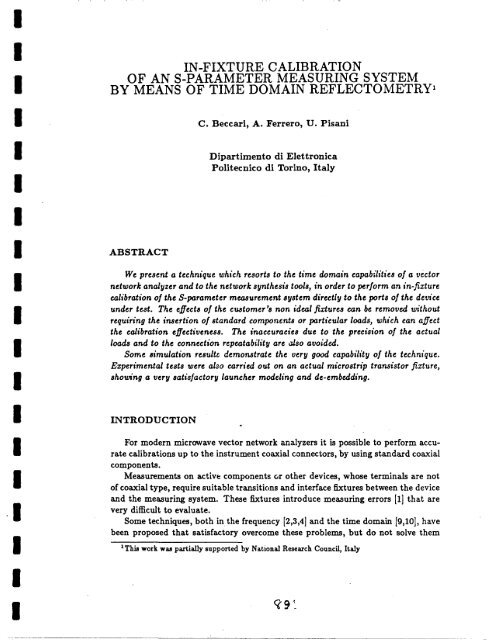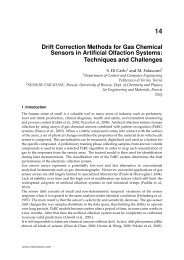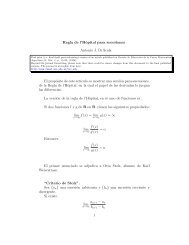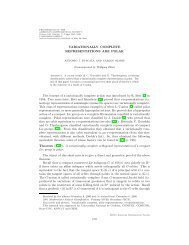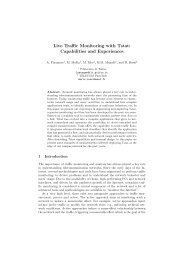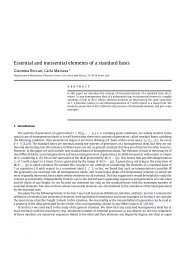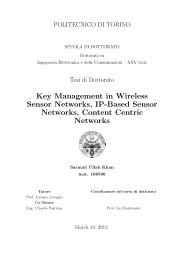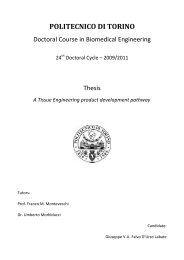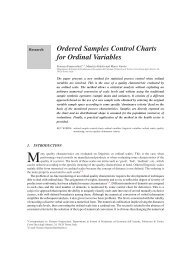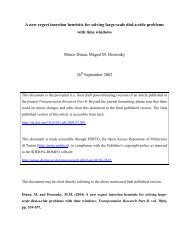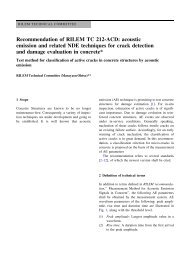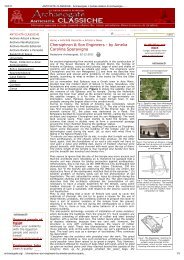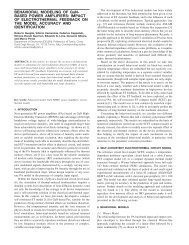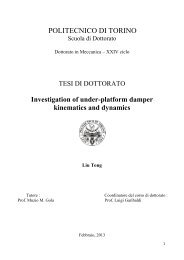In-Fixture Calibration of an S-Parameter Measuring System by ...
In-Fixture Calibration of an S-Parameter Measuring System by ...
In-Fixture Calibration of an S-Parameter Measuring System by ...
You also want an ePaper? Increase the reach of your titles
YUMPU automatically turns print PDFs into web optimized ePapers that Google loves.
I<br />
1<br />
I<br />
1<br />
1<br />
1<br />
. . . . -<br />
IN-FIXTURE CALIBRATION<br />
OF AN S-PARAMETER MEASURING SYSTEM<br />
BY MEANS OF TIME DOMAIN REFLECTOMETRY1<br />
ABSTRACT<br />
C. Beccari, A. Ferrero, U. Pis<strong>an</strong>i<br />
Dipartimento di Elettronica<br />
Politecnico di Torino, Italy<br />
We present a technique which resorts to the time domain capabilities <strong>of</strong> a vector<br />
network <strong>an</strong>alyzer <strong>an</strong>d to the network synthesia tools, in order to perform <strong>an</strong> in-fizture<br />
calibration <strong>of</strong> the S-purameter measurement system directly to the ports <strong>of</strong> the device<br />
under test. The effects <strong>of</strong> the cwtomer's nori ideal fiztures c<strong>an</strong> be removed without<br />
requiring the insertion <strong>of</strong> st<strong>an</strong>dard components or particular loads, which c<strong>an</strong> afect<br />
the calibration efectiveness. The inaccuracies due to the precision <strong>of</strong> the actual<br />
loads <strong>an</strong>d to the connection repeatability are also avoided.<br />
Some simulation reeulte demonstrate the very god capability <strong>of</strong> the technique.<br />
Ezperimental tests were ab0 carried out on <strong>an</strong> actual microstrip tr<strong>an</strong>sistor fizture,<br />
showing a very eatisfactoty launcher modeling <strong>an</strong>d de-embedding.<br />
INTRODUCTION<br />
For modern microwave vector network <strong>an</strong>alyzers it is possible to perform accu-<br />
rate calibrations up to the instrument coaxial c<strong>an</strong>nectors, <strong>by</strong> using st<strong>an</strong>dard coaxial<br />
components.<br />
Measurements on active components Gr other devices, whose terminals are not<br />
<strong>of</strong> coaxial type, require suitable tr<strong>an</strong>sitions <strong>an</strong>d interface fixtures between the device<br />
<strong>an</strong>d the measuring system. These fixtuxes introduce measuring errors [l] that are<br />
very difficult to evaluate.<br />
Some techniques, both in the frequency [2,3,4] <strong>an</strong>d the time domain (9,101, have<br />
been proposed that satisfactory overcome these problems, but do not solve them<br />
'This work WM partially supported <strong>by</strong> National Research Council, Italy
completely; in facts there remains the uncertainty <strong>of</strong> the connections repeatability<br />
(especially with MMIC fixtures); furthermore at higher frequencies the characteris-<br />
tic imped<strong>an</strong>ce <strong>of</strong> the delay line is subjected to variations that influence the tr<strong>an</strong>sition<br />
identification in a way that is difficult to evaluate.<br />
An ideal calibration procedure should be capable <strong>of</strong> characterizing the fixture<br />
without relying on <strong>an</strong>y sort <strong>of</strong> assembly/disassembly for the insertion <strong>of</strong> the st<strong>an</strong>dard<br />
loads.<br />
The procedure that we describe meets the above requirements, because, after<br />
calibrating the network <strong>an</strong>alyzer up to the coaxial ports [?I, it consists in measuring<br />
only the empty fixture.<br />
The facilities <strong>of</strong>fered <strong>by</strong> the network <strong>an</strong>alyzer HP 8510 (81 are essential for the<br />
perform<strong>an</strong>ce <strong>of</strong> the proposed techniques, which consists in isolating single echoes <strong>of</strong><br />
the time domain response <strong>of</strong> the fixture.<br />
This instrument performs frequency measurements <strong>of</strong> the S-parameters on a<br />
frequency b<strong>an</strong>d, that c<strong>an</strong> be very wide, depending on the instrument hardware; the<br />
sampled frequency measurements are stored into one <strong>of</strong> the instrument memories,<br />
<strong>an</strong>d may be acted upon with mathematical tools, such as the chirp-z tr<strong>an</strong>sform, in<br />
order to get the impulse response <strong>of</strong> the device under test (51.<br />
The reflect<strong>an</strong>ce echoes <strong>of</strong> the time response may be gated, stored in different<br />
memories, <strong>an</strong>d acted upon with the same tools.<br />
If the first echo is isolated as said before, it c<strong>an</strong> be viewed as the input impulse<br />
response <strong>of</strong> a two port whose output port is matched. Reverting to the frequency<br />
domain, the reflect<strong>an</strong>ce corresponding to this echo may be viewed as the input<br />
scattering parameter <strong>of</strong> this two port.<br />
Assuming that it is a lossless network, circuit theory allows to identify almost<br />
completely its whole scattering matrix, a part a delay on the input <strong>an</strong>d on the<br />
output aide; these delays may be modeled with lines, although the output line is <strong>of</strong><br />
less interest, because its effects may be included into the delay that separates one<br />
echo from the next one.<br />
By matching the model input reflect<strong>an</strong>ce phase with the actual one, <strong>by</strong> me<strong>an</strong>s<br />
<strong>of</strong> the insertion <strong>of</strong> a suitable length <strong>of</strong> line, it is possible to obtain a complete model<br />
<strong>of</strong> the discontinuity that caused the first echo.<br />
This model c<strong>an</strong> be deembedded from the initial measurements, <strong>an</strong>d the proce-<br />
dure started again on the first residual echo.<br />
The effects <strong>of</strong> the discontinuity de-embedding may be easily checked <strong>by</strong> exam-<br />
ining the residual time domain response; the errors, due to the approximations<br />
implied <strong>by</strong> this procedure, may be checked in the frequency domain <strong>by</strong> examining<br />
the effect <strong>of</strong> de-embedding on the input reflect<strong>an</strong>ce <strong>of</strong> the gated discontinuity; we<br />
did not experience <strong>an</strong>y difEculty in obtaining residual errors lower th<strong>an</strong> -40 dB.<br />
99
DISCONTINUITY MODELING<br />
As said before, <strong>by</strong> me<strong>an</strong>s <strong>of</strong> the gating facilities <strong>of</strong> the network <strong>an</strong>alyzer, it is<br />
possible to isolate the first discontinuity echo, whose chirp-z tr<strong>an</strong>sform represents<br />
the input scattering parameter Sll <strong>of</strong> the two-port, that models the discontinuity,<br />
<strong>an</strong>d that may be reasonably assumed to be lossless.<br />
Another reasonable assumption is that this model is made up with a lumped<br />
part preceded <strong>by</strong> a length <strong>of</strong> line, which is needed to match the parameter overall<br />
phase shift; some experimental tests carried out on typical microstrip launchers<br />
convinced us to limit the lumped part complexity to the second order.<br />
Since the phase shift introduced <strong>by</strong> the aforementioned line does not influence<br />
the magnitude, the latter c<strong>an</strong> be approximated independently, <strong>an</strong>d in particular it<br />
is possible to carry out the approximation procedure on the characteristic function<br />
F, which is tied to the squared magnitude <strong>of</strong> Sll <strong>by</strong> the equation:<br />
This ch<strong>an</strong>ge <strong>of</strong> the approximation function is quite recommended, since the charac-<br />
teristic function is subjected to less stringent realizability conditions compared to<br />
&I.<br />
With the second order assumption, <strong>an</strong>d excluding unusual topologies that are<br />
very unlikely apt to model the kind <strong>of</strong> discontinuity we are dealing with, the math-<br />
ematical form <strong>of</strong> the characteristic function squared magnitude is:<br />
IFC(jW)l' =<br />
Aw' + Bw2 + C<br />
where n determines the function type, that is lowpass, b<strong>an</strong>dpass, or highpass, <strong>an</strong>d<br />
A <strong>an</strong>d partially B determine the function degree [ll].<br />
The above squared magnitude may be approximated <strong>by</strong> me<strong>an</strong>s <strong>of</strong> a weighted<br />
least squares algorithm, subjected to simple conditions, in order to guar<strong>an</strong>tee that<br />
it remains non negative for every w.<br />
After some simple algebra, the characteristic function is obtained:<br />
FC(4 =<br />
W*n<br />
as2 + bs + c - -- h(s)<br />
8" f ($1<br />
<strong>an</strong>d the characteristic equation may be solved:<br />
<strong>an</strong>d eventually the whole scattering matrix <strong>of</strong> the lumped part <strong>of</strong> the discontinuity<br />
tw*port model is obtained. At this point the phase shift <strong>of</strong> the lumped part <strong>of</strong> SI1<br />
is compared with the gated reflect<strong>an</strong>ce phase, <strong>an</strong>d matched with a length <strong>of</strong> line<br />
that introduces a delay 7.
Once we have the complete model <strong>of</strong> the discontinuity, we c<strong>an</strong> de-embed its<br />
effects <strong>by</strong> me<strong>an</strong>s <strong>of</strong> well known circuit theory procedures that use the tr<strong>an</strong>smission<br />
matrix <strong>of</strong> the model: in details, all this corresponds to computing the inverse <strong>of</strong> the<br />
tr<strong>an</strong>smission matrix <strong>of</strong> the discontinuity model, <strong>an</strong>d to compute its input reflect<strong>an</strong>ce<br />
when the output is loaded on the measured reflect<strong>an</strong>ce.<br />
EXPERIMENTAL RESULTS<br />
The procedure described in the previous section has been thoroughly tested on<br />
simulated data obtained from the <strong>an</strong>alysis <strong>of</strong> known circuits, <strong>an</strong>d the parameters<br />
<strong>of</strong> the original circuits were const<strong>an</strong>tly obtained again within a precision <strong>of</strong> a few<br />
percent, when the frequency data were limited to just 201 samples between 130 MHz<br />
<strong>an</strong>d 23.13 GHa.<br />
Among others we tested a complicated circuit, that included three lumped dis-<br />
continuities separated <strong>by</strong> two lines, <strong>an</strong>d exhibited a very bad reflect<strong>an</strong>ce never better<br />
th<strong>an</strong> - 7 dB on the entire frequency b<strong>an</strong>d.<br />
The final residual reflect<strong>an</strong>ce after the complete de-embedding was lower th<strong>an</strong><br />
-50 dB up to 10 GHz, while it increased up to -10 dB at the upper frequency end;<br />
the residual echo (which should have been ideally zero) was hardly noticeable when<br />
plotted together with the original one.<br />
We applied this technique in order to model a user built microstrip fixture, that<br />
was intended for measuring packaged MESFETs, figure 1. This fixture may be<br />
viewed as a four port circuit: ports 1 <strong>an</strong>d 2 are connected to the network <strong>an</strong>alyzer<br />
through the coaxial connectors, while the other ports 3 <strong>an</strong>d 4 are those where the<br />
device under test should be connected; the empty fixture exhibits between ports 3<br />
<strong>an</strong>d 4 a capacitive coupling (corresponding to the gap between the line ends) which<br />
is highly reflective.<br />
After calibrating the network <strong>an</strong>alyzer to the coaxial ports <strong>by</strong> me<strong>an</strong>s <strong>of</strong> the usual<br />
twelve term calibration, the scattering matrix <strong>of</strong> the empty fixture was measured.<br />
The time domain response associated with the input reflect<strong>an</strong>ce is shown in<br />
figure 2, <strong>an</strong>d a similar behaviour is exhibited at the output port; the launcher echo<br />
is clearly visible, while the second large echo is produced <strong>by</strong> the capacitive gap;<br />
multiple reflections are responsible <strong>of</strong> the ripples that appear especially after the<br />
gap echo.<br />
The first echo is gated out <strong>by</strong> me<strong>an</strong>s <strong>of</strong> the gating facility <strong>of</strong> the network <strong>an</strong>alyzer,<br />
<strong>an</strong>d modeled with the procedure described above; a first attempt to model the<br />
launcher with a first order low pass function matched the discontinuity reflect<strong>an</strong>ce<br />
magnitude in a way that was not considered sufficiently satisfactory, while a second<br />
order Row pass function was found adequate to match the reflect<strong>an</strong>ce magnitude<br />
with acceptable accuracy; after this a line length was determined in order to match<br />
the total reflect<strong>an</strong>ce phase. The Smith chart plot <strong>of</strong> the actual <strong>an</strong>d approximated
' I 0.5" 4<br />
*A-<br />
Figure 1: Sketch <strong>of</strong> the microstrip fixture<br />
*11 R.<br />
REF 0.0 Unit.<br />
200.0 d.Jnit./<br />
STAu-t 0.0 .<br />
STQD 1.0 ne<br />
Figure 2: Time domain response at port 1.<br />
93
eflect<strong>an</strong>ce <strong>of</strong> the first discontinuity is shown in figure 3.<br />
As a <strong>by</strong> product <strong>of</strong> this technique a circuit model <strong>of</strong> the microstrip launcher c<strong>an</strong><br />
be synthesized, as it is shown in figure 4.<br />
The tr<strong>an</strong>smission matrix <strong>of</strong> the launcher model c<strong>an</strong> be now used to deembed<br />
the launcher effects from the fixture scattering parameters; at the input side the<br />
residual reflect<strong>an</strong>ce corresponds to a time domain response as shown in figure 5,<br />
where the echo <strong>of</strong> the first discontinuity is almost completely c<strong>an</strong>celed, <strong>an</strong>d the gap<br />
echo is shifted to the left <strong>by</strong> the amount <strong>of</strong> the dckmbedded delay.<br />
Similar steps c<strong>an</strong> be performed on the output side <strong>of</strong> the fixture. Repeating the<br />
whole procedure eventually the entire fixture c<strong>an</strong> be adequately modeled, figure 6.<br />
For what concerns the highly reflective gap discontinuity it must be noticed<br />
that numerical problems may arise, which may reduce the approximation accuracy.<br />
Nevertheless this fact is assumed to be <strong>of</strong> less import<strong>an</strong>ce, since the signific<strong>an</strong>t point<br />
is to determine the last line length in order to shift the reference pl<strong>an</strong>es to ports 3<br />
<strong>an</strong>d 4; in facts the gap discontinuity is external to the fixture model because it will<br />
be substituted <strong>by</strong> the device under test.<br />
For this reason we are developing a different procedure in order to approximate<br />
the final internal discontinuity <strong>by</strong> generating its whole scattering matrix, instead <strong>of</strong><br />
working with just one reflect<strong>an</strong>ce.<br />
CONCLUSION<br />
We presented a technique suitable for modeling microstrip fixtures in order to<br />
allow to de-embed the effects <strong>of</strong> the discontinuities, <strong>an</strong>d to shift the reference pl<strong>an</strong>es<br />
<strong>of</strong> <strong>an</strong> ideal reflectometer to the physical ports <strong>of</strong> the device under test. The pro-<br />
cedure allows to calibrate the network <strong>an</strong>alyzer to these ports without using mi-<br />
crostrip components as st<strong>an</strong>dard loads, <strong>an</strong>d without assembling/disassembling the<br />
measuring fixture.<br />
The results that we obtained are very satisfactory, <strong>an</strong>d the procedure seems to<br />
be applicable to other kinds <strong>of</strong> fixtures, also those that are built directly <strong>by</strong> the user<br />
for his specific applications.<br />
94
*11 z<br />
REF 1.0 Units<br />
200.0 mUnits/<br />
hP<br />
START 0.045000000 W z<br />
STOP 18.045000000 GHz<br />
Figure 3: Smith chart plot <strong>of</strong> the gated <strong>an</strong>d the modeled reflect<strong>an</strong>ce.<br />
I<br />
I<br />
I 500<br />
I T= 56.4~~<br />
I<br />
I I<br />
375 pH<br />
0.99 : 1<br />
Figure 4: Circuit mode1 <strong>of</strong> the launcher.<br />
50 n
H<br />
511 R.<br />
REF 0.0 Units<br />
200.0 &nit./<br />
START 0.0 t<br />
mP 1.0 nt<br />
Figure 5: Time domain response without the effects <strong>of</strong> the launcher.<br />
PORT PORT WRT PORT<br />
1 3 4 2<br />
Figure 6: Four port model <strong>of</strong> the fixture.
1<br />
I<br />
I<br />
REFERENCES<br />
R. L<strong>an</strong>e, " De-embedding device scattering parameters", Microwave Joum.<br />
vol. 27, n. 8, 1984, pp. 149-156.<br />
S. E. Rosenbaum, 0. Pitzalis Jr., J. M. Marz<strong>an</strong>, "A calibration method for de-<br />
embedding a microwave test fixture", 27-th ARFTG Conf. Digest, Baltimore,<br />
June 1986.<br />
G. F. Engen, C. A. Hoer, "Thru-Reflect-Line: An improved technique for<br />
calibrating the dual six-port automatic network <strong>an</strong>alyzer", IEEE Tr<strong>an</strong>s. on<br />
Microwave Theory <strong>an</strong>d Technique, vol. MTT-27, n. 12, 1979, pp. 987-993.<br />
N. R. Fr<strong>an</strong>zen, R. A. Speciale, "A new procedure for system calibration <strong>an</strong>d<br />
error removal in automated S-parameter measurements", Proc. 5th Europe<strong>an</strong><br />
Microwave Conf., Hamburg 1975, pp. 69-73.<br />
P. I. Somlo, J. D. Hunter, "Microwave imped<strong>an</strong>ce measurements", Peter Pere-<br />
grinus Ltd., London 1985, chapt. 6, pp.147-178.<br />
M. E. Hines, H. E. Stinehelfer Sr., "Time-domain oscillographic microwave<br />
network <strong>an</strong>alysis using frequency-domain data", IEEE T~<strong>an</strong>s. on MTT, vol.<br />
MTT-22, 1974, pp.276282.<br />
J. K. Fitzpatrick, "Error models for system measurements", Microwave Joum.<br />
1978, n. 5, pp. 63-66.<br />
Hewlett-Padrard 8510 Network <strong>an</strong>alyzer operating <strong>an</strong>d service m<strong>an</strong>ual, vol.<br />
1, 1984, pp.77-84.<br />
H. E. Stinehelfer Sr., "Discussion <strong>of</strong> de-embedding techniques using time-<br />
domain <strong>an</strong>alysis.", IEEE Proc. Vol. 74, n. 1, 1986, pp. 90-94.<br />
H. E. Stinehelfer Sr., "De-embedding the capacit<strong>an</strong>ce <strong>of</strong> a reson<strong>an</strong>t circuit<br />
using time-domain reversal <strong>an</strong>d subtraction". IEEE MTT Digest, 1982, pp.<br />
354-356.<br />
C. Beccari, U. Pis<strong>an</strong>i, " Automatic discontinuity de-embedding in S-parameter<br />
measurement system", Alta Frequenza, vol. LVII, n. 5, 1988, pp. 249-257.


